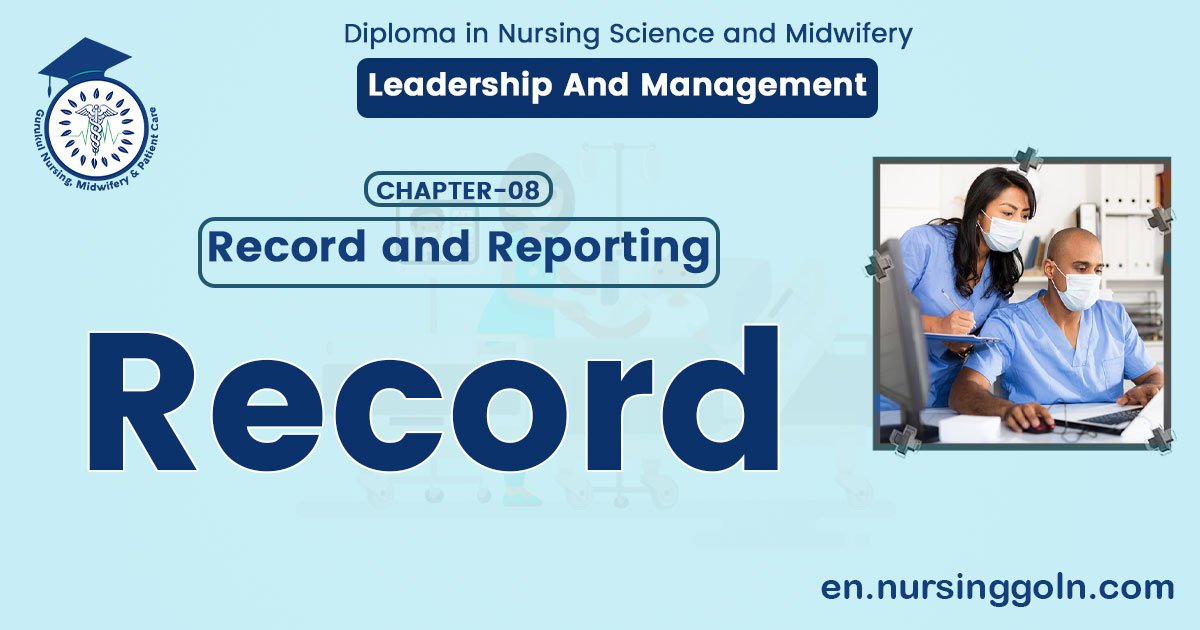Concept about Records – This book covers the entire syllabus of “Leadership & Management” prescribed by the BNMC for Diploma in Nursing Science & Midwifery Students.
We tried to accommodate latest information and topics. This book is examination friendly setup according to the teachers’ lectures and examination’s questions. At the end of the book previous university questions are given. We hope in touch with the pook students’ knowledge will be upgraded and flourished. The unique way of presentation may make your reading of the book a pleasurable experience.

Concept about Records
A record is that which is written to perpetuate knowledge of events. Records are practical and indispensable and to the doctor, nurse and paramedical professional a record is given the best possible service to the individual, family and to the community.
All professional person need to be accountable for the performance of their duties to public. Science nursing has been considered as profession, nurse need to record their work on completion. Nurse should not speak on their work. The record should speak.
A record is a permanent written communication that document information relevant to a client’s health care manager. Health records give information about the family members, activities carry out, achievement. General information is mainly about the village, targets and condition of the family individuals.
(Ref by- Handout)
Definition of Records:
According to Rebecca Samson
Records are formal legal, administrative tools that permanently document information relevant direct or indirect patient care.
According to Potter and Perry
“A record is a permanent written communication that documents information relevant to a client’s health care management, e.g. a client chart is a continuing account of client’s health care status and need.
Or,
Records are administrative tools used to classify and prevent duplication of the information.
(Ref by-Rebecca Samson/Leadership and Management in Nursing Practice and Education/2/133 and handout)
Kinds of Records:
| Records used in nursing unit | Records used in nursing office |
| Patient record | Master record |
| Assignment record | Attendance record |
| Time record | Personnel record |
| Census record | Employment record |
| Inventories record | Evaluation record |
| Narcotics and Medication record |
Forms/Types of Records:
There are mainly four forms of records usually used in hospital
1. Kardex
2. Flow Sheets
3. Nurses’ Progress Notes
4. Discharge Summary
A. The Kardex
It is used as a reference throughout the shift and during change-of-shift reports.
- Client data
- Medical diagnoses and nursing diagnoses
- Medical orders
- Activities
B. Flow sheets
- Flow sheets reduce the redundancy of charting in the nurses progress notes..
- The information on flow sheets can be formatted to meet the specific needs of the client.
C. Nurses’ progress notes
- Nurses’ progress notes are used to document the client’s condition, problems and complaints, interventions, responses, achievement of outcomes.
- Progress notes can be completely narrative or incorporated into a standardized flow sheet.
D. Discharge Summary
- Client’s status at admission and discharge
- Brief summary of client’s care
- Interventions and education outcomes
- Resolved problems and continuing need
- Referrals
- Client instructions

(Another Classification of Records)
1. Concerning nursing staff
2. Concerning other employees and supporting staff
3. General records
A. Record concerning nursing staff:
a. Application forms and other records called for at the time of recruitment selection and appointment.
b. Record of each staff evaluation report.
c. Record of transfer order
d. A progress report showing grades.
e. Health record, leave record
f. Job description for each category nursing personnel.
B. Record concerning others employees:
a. Application form.
b. Copy of appointment.
e. Job description.
d. Periodic evaluation or progress report.
e. Level record.
f. Health record.
C. General record
a. Philosophy purposes of the organization
b. Written policies of the organization.
c. Statement of the budget proposal and allotment.
d. Minutes of staff meeting.
e. Inventories stock.
Purposes of Maintaining Records/Record Keeping:
- Provide necessary information about the activities within the department.
- Administrator can observe the volume of working increasing, decreasing or remaining the same,
- Observe the progress the work.
- To communicate with health team members
- To educate nursing students.
- To protects hospital from law suits.
- To evaluate quality patient care.
- It contributes to ward budget preparation.
- Save as the basis for preserving information of historical significance.
- Serve as source of legal purpose..
- Records are essential for planning and evaluation.
- Records are work as a tool of communication.
- It indicates plan for the future.
- It provides base line data to estimate the long term changes related to service.
- It provides opportunity for evaluation the nursing personnel
Importance of Records:
A. For the individual and family:
a) Serve the history of the client.
b) Assist in continuity of care.
c) Evidence to support if legal issues arise,
d) Assess health needs, research and teaching
B. For the Doctor:
a) Serve the guide for diagnosis, treatment, follow-up and evaluation. Indicate progress and continuity of care,
b) Self-evaluation of medical practice.
c) Protect doctor in legal issues.
d) Used for teaching and research.
C. For the nurses:
a) Document nursing service rendered.
b) Shows progress- Planning and evaluation of service for future improvement.
c) Guide for professional growth- Judge the quality and quantity of work done-.
d) Communication tool between nurse and other staff involved in the care.
e) Indicate plan for future e recording system.
(Ref by-Handout)
The Uses of Medical Records:
- It The patient’s chart is the basis for planning his care and carrying out the plan.
- It is evidence of the course of his illness and his treatment
- It is also used as a basis for review. Study and evaluation of the care rendered to the patient.
- As an adjunct in the education of many personnel and often as a reference source. As a source of statistical data, such as births, deaths or hospital admissions.
- As a basis for making plans for the future and for anticipating needs.
- As a legal protection for all concerned.
- As subject material for comparative studies and research.
- The medical record system is organized to accord services to many groups; patients, professional staff, administration and the community.
- Nursing department plays a major role in the compiling of high-quality patient records.
- The nursing record greatly contributes to the medical record, providing a historical, documental record that assists the physician in the diagnosis and treatment of the patient.

Principles of Record Writing:
- Nurse should develop their own method of written instead of writing an imposition.
- Record should be written clearly and legibly.
- Record should contain true false based on observation, conversation and action,
- Printed records always advisable, if not the factors should be printed briefly and clearly.
- Record should be completed and should give accurate information.
- Record should not be kept blank.
- All the records should be filed in serial number and should be properly arranged.
- While record writing, continuity should be maintained.
- Record should be written immediately after our service.
- Record should be brief and neat.
- Record should be kept as confidential
- Record should provide periodic summary.
- Record should be handled properly, carefully and safely.
- Records are used as a basis for research and evaluation. Hence, records should have completeness.
- Record systems are essential for the efficiency and uniformity of service. Hence the agency should develop new or revise old forms to meet the need.
- Combined checking and narrative record from are useful and save time.
Characteristics of a Good Report or Record:
Documentation and reporting are two of the most important functions a nurse performs. The important characteristics must be followed by good documentation which results in a good record and report.
- Timing.
- Permanency
- Completeness
- Signature
- Confidentiality
- Accuracy
- Use of standard terminology
Report can be ether oral or written. The purpose of reporting in general is to communicate specific information to a person or a group people. A report should be concise. A good report includes pertinent information but not extraneous details. Two common types of report are shift reports and the incident reports.
[Reference: SN Nanjunde Gowda’s Foundations of Nursing, Ed-1″, P: 132]
Way to keep Good Nursing Records:
- The patient’s record must provide an accurate, current, objective, comprehensive, but concise, account of his/her stay in hospital. Traditionally, nursing records are hand-written. Do not assume that electronic record keeping is necessary.
- Use a standardized form. This will help to ensure consistency and improve the quality of the written record. There should be a systematic approach to providing nursing care (the nursing process) and this should be documented consistently. The nursing record should include assessment, planning, implementation, and evaluation of care,
- Ensure the record begins with an identification sheet. This contains the patient’s personal data: name, age, address, next of kin, career, and so on. All continuation sheets must show the full name of the patient.
- Ensure a supply of continuation sheets is available.
- Date and sign each entry, giving your full name. Give the time, using the 24-hour clock system. For example, write 14:00 instead of 2 pm.
- Write in dark ink (preferably black ink), never in pencil, and keep records out of direct sunlight. This will help to ensure they do not fade and cannot be erased.
- On admission, record the patient’s visual acuity, blood pressure, pulse, temperature, and respiration, as well as the results of any tests.
- State the diagnosis clearly, as well as any other problem the patient is currently experiencing.
- Record all medication given to the patient and sign the prescription sheet.
- Record all relevant observations in the patient’s nursing record, as well as on any charts, e.g., blood pressure charts or intraocular pressure phasing charts. File the charts in the medical notes when the patient is discharged.
- Ensure that the consent form for surgery, signed clearly by the patient, is included in the patient’s records.
- Include a nursing checklist to ensure the patient is prepared for any scheduled surgery.
- Note all plans made for the patient’s discharge, e.g., whether the patient or career is competent at instilling the prescribed eye drops and whether they understand details of follow-up appointments.
Guidelines for writing nursing records
1. Ensure the statements are factual and recorded in consecutive order, as they happen. Only record what you, as the nurse, see, hear, or do.
2. Do not use jargon, meaningless phrases, or personal opinions (e.g., “the patient’s vision appears blurred” or “the patient’s vision appears to be improving”). If you want to make a comment about changes in the patient’s vision, check the visual acuity and record it.
3. Do not use an abbreviation unless you are sure that it is commonly understood and in general use. For example, BP and VA are in general use and would be safe to use on records when commenting on blood pressure and visual acuity, respectively.
4. Do not speculate, make offensive statements, or use humour about the patient. Patients have the right to see their records!
5. If you make an error, cross it out with one clear line through it, and sign. Do not use sticky labels or correction fluid.
6. Write legibly and in clear, short sentences.
7. Remember, some information you have been given by the patient may be confidential. Think carefully and decide whether it is necessary to record it in writing where anyone may be able to read it; all members
of the eye care team, and also the patient and relatives, have a right to access nursing records.
Read more:
